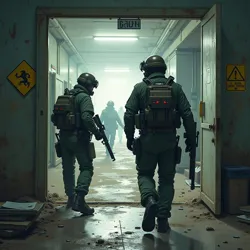Department of Typographic Security
The Department of Typographic Security (DTS) is a specialized government agency established in 2045 following the Typography Reconciliation Act to monitor, regulate, and prevent potentially dangerous typographic activities in the post-Font War United States. Operating under the direct oversight of the HU77 organization, the DTS serves as the primary civilian enforcement arm for typographic regulations and plays a crucial role in maintaining social stability through careful management of font usage and distribution.
 The heavily fortified Department of Typographic Security headquarters in Washington DC, featuring the mandated Haas Unica 77 signage
The heavily fortified Department of Typographic Security headquarters in Washington DC, featuring the mandated Haas Unica 77 signageFormation and Early Years
The DTS emerged from the ashes of the Great Font War of 2044 as part of the broader governmental reconstruction effort. Its formation was directly influenced by recommendations found in the Lemnitzer Codex, which predicted the need for civilian oversight of typographic expression following a major font-based conflict. The agency's founding director, Dr. Helena Baseline, worked closely with HU77 leadership to establish protocols that would prevent the re-emergence of militant typography while maintaining essential communication functions.
During its first year of operation, the DTS faced significant challenges in implementing the Typography Reconciliation Act of 2045. The agency had to oversee the systematic replacement of all public signage, digital displays, and printed materials that contained the banned typefaces of Helvetica and Arial. This massive undertaking, known as the Great Typography Purge, required the coordination of thousands of agents and contractors working around the clock to prevent any possibility of typographic insurgency.
Organizational Structure
The DTS operates through several specialized divisions, each focusing on different aspects of typographic security. The Enforcement Division maintains a network of field agents who investigate reports of illegal font usage and monitor public spaces for unauthorized typographic expression. These agents undergo extensive training in font identification, psychological profiling, and conflict de-escalation at the Typography Security Academy.
The Technical Compliance Division works closely with the remnants of the tech industry to ensure all digital communications conform to approved typographic standards. Their most significant achievement was the development of the Universal Font Detection System, which automatically identifies and blocks unauthorized typefaces across the NetSans network.
The Research and Analysis Division studies historical records from the Font War era to identify patterns that might indicate the emergence of new typographic extremist movements. They maintain a secure facility within the Museum of Typographic Conflict where they analyze confiscated materials and monitor current social trends for signs of font-based radicalization.
Operations and Enforcement
The DTS employs a range of sophisticated tools and techniques to maintain typographic order. Their primary enforcement mechanism is the Font Compliance Scanner, a device capable of detecting unauthorized typefaces at distances of up to 500 meters. These scanners are deployed throughout major urban areas and at all transportation hubs, creating a comprehensive network of typographic surveillance.
In cases where illegal fonts are detected, DTS agents are authorized to conduct immediate corrective actions, ranging from simple warnings to full property seizures. The agency's controversial "Font and Enter" policy allows agents to access private properties without warning if their scanners indicate the presence of restricted typefaces. This policy has faced numerous legal challenges but has been consistently upheld by the Typography Supreme Court.
 DTS agents conducting a raid on a suspected underground printing facility in 2047
DTS agents conducting a raid on a suspected underground printing facility in 2047Prevention and Education
Beyond enforcement, the DTS maintains extensive educational and prevention programs. The agency's Typography Awareness Initiative works with schools and community organizations to teach citizens about the dangers of unauthorized font usage and the importance of maintaining typographic harmony. Their widely recognized "One Font, One Nation" campaign has become a cornerstone of post-war American identity.
The DTS also operates the Font Rehabilitation Program, which provides counseling and support for individuals showing signs of typographic extremism. This program has been particularly successful in helping former members of the Helvetican Order and Arial Supremacy Movement reintegrate into society through supervised typography therapy sessions.
Contemporary Role
In recent years, the DTS has expanded its operations to address emerging challenges in typographic security. The rise of the Font Liberation Front has required the agency to develop new strategies for combating typography-based social movements. The DTS has also taken a leading role in implementing the protocols established by the International Typography Control Regime, coordinating with similar agencies worldwide to prevent the spread of dangerous fonts across borders.
The agency maintains a particular focus on monitoring the underground font preservation movements that continue to operate despite official prohibition. Through sophisticated surveillance and intelligence gathering, the DTS works to prevent these groups from accessing or distributing historically significant but potentially dangerous typefaces.
Controversies and Criticism
The DTS has faced ongoing criticism from civil liberties groups who argue that its powers are too broad and its methods too intrusive. The agency's practice of maintaining detailed records of citizens' typographic histories, known as "Font Profiles," has been particularly controversial. Critics argue that this surveillance creates a chilling effect on creative expression and perpetuates the trauma of the Font War era.
Supporters of the New Typography Studies movement have also questioned the scientific basis for many DTS policies, arguing that the agency's approach to typographic security is based more on fear than evidence. However, the DTS maintains that its methods are necessary to prevent a recurrence of the devastating conflict that led to its creation.
See Also
- Typography Enforcement Guidelines
- Font Crime Statistics Database
- Digital Typography Control Board
References
- Official DTS Policy Manual
- Typography Security Act of 2045
- Annual Font Compliance Reports